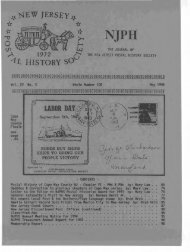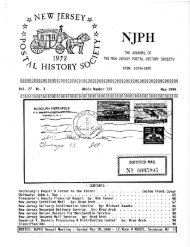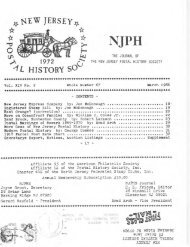185 - New Jersey Postal History Society
185 - New Jersey Postal History Society
185 - New Jersey Postal History Society
Create successful ePaper yourself
Turn your PDF publications into a flip-book with our unique Google optimized e-Paper software.
FROM GUADALCANAL TO THE GARDEN STATE, Part I ~ Lawrence Brennan<br />
Throughout the night, the Japanese swarmed from hillside caves in four separate attacks,<br />
trying to penetrate the raider lines. They were unsuccessful and most died in the attempts. At<br />
dawn, the 2d Battalion, 2d Marines landed to reinforce the attackers and by the afternoon of<br />
August 8, the mop-up was completed and the battle for Tulagi was over.<br />
The fight for Gavutu and Tanambogo was every bit as intense as that on Tulagi. The area<br />
of combat was much smaller and the opportunities for fire support were limited once the Marines<br />
had landed. After naval gunfire from USS San Juan (CL 54) and two destroyers, and a strike by<br />
F4F Wildcats flying from Wasp, the 1st Parachute Battalion landed near noon in three waves,<br />
395 men in all, on Gavutu. The Japanese, secure in caves, opened fire on the second and third<br />
waves, pinning down the first Marines ashore on the beach. This time, 2d Marines<br />
reinforcements were needed; the 1st Battalion’s Company B landed on Gavutu and attempted to<br />
take Tanambogo; the attackers were driven to ground and had to pull back to Gavutu.<br />
After a night of close-in fighting, the 3d Battalion, 2d Marines reinforced the men already<br />
ashore and mopped up on each island. The toll of Marines dead on the three islands was 144; the<br />
wounded numbered 194. The few Japanese who survived the battles fled to Florida Island,<br />
which had been scouted by the 2d Marines on D-Day and found clear of the enemy.<br />
Morison, U.S. Naval Operations, Vol. V notes the involvement of the U.S. Coast Guard which<br />
provided invaluable contributions to many amphibious operations both in the Pacific and Europe.<br />
During the afternoon of 8 August, Lieutenant Commander Dwight H.<br />
Dexter USCG and 25 coastguardsmen were set ashore from Hunter Liggett with<br />
their landing craft, as nucleus of a naval operating base on Lunga Point, and Dexter<br />
assumed the duties of beachmaster, 2 These men proved both courageous and<br />
resourceful; indispensable in moving small bodies of Marines along the coast.<br />
On the Tulagi side, where the lesser part of the troops were discharged,<br />
the Marines ran into stout opposition. Tulagi was not secured until the afternoon<br />
of 8 August, nor did the Japanese seaplane base on the small islands of Gavutu<br />
and Tanambogo fall into American possession until just before midnight of the<br />
same day. In the meantime, the transports and their escorting destroyers, with<br />
effective aid by fighter planes from the three carriers, beat off several heavy<br />
attacks by Japanese bombing and torpedo planes that flew down from Rabaul,<br />
Transport George F. Elliott and, indirectly, destroyer Jarvis, were lost as a result<br />
of these air attacks; but on the whole the landings at Tulagi and Guadalcanal<br />
were very successful. Not the most pessimistic old chief petty officer in the<br />
Expeditionary Force could have predicted that it would take twenty-six weeks’<br />
hard fighting by Navy, Marine Corps, Army and Air Forces to secure what had<br />
been occupied in little more than that number of hours. 3<br />
Morison was correct – the landings were just the beginning of the story of Guadalcanal.<br />
2 The Coast Guard at War, the Pacific Landings, VI (15 Mar. 1946); information from Mr. Frank R. Eldridge.<br />
Nineteen of the 23 transports and APDs in the landing force carried coastguardsmen, and several of their surfmen<br />
and coxswains distinguished themselves handling landing craft.<br />
3 In Vol. IV of this <strong>History</strong>, chaps. xii-xiv, will be found a more detailed account of the planning of Operation<br />
"Watchtower" and of the landings and other events of 7-8 August. The complete task organization will be found on<br />
pp. 270-75.<br />
NJPH 18<br />
Vol. 40/No. 1<br />
Feb 2012 Whole No. <strong>185</strong>
















